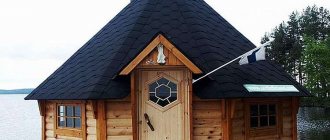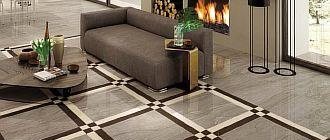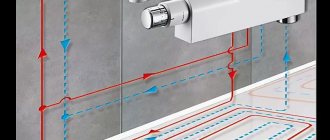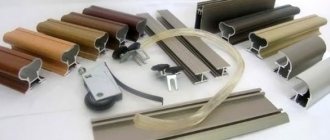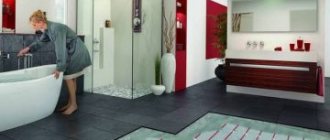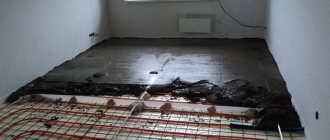Features of wooden floor:
- Less load on load-bearing structures - in some cases there are restrictions on the maximum load on load-bearing structures and the weight of the floor, and it is not possible to organize a cement-sand screed (its weight is approximately 1400 kg/10 m2). In this case, a wooden floor is the solution to the problem.
- Wood requires better thermal and waterproofing
- Wooden floors have a high fire hazard
- Wooden floors are more susceptible to deterioration and rotting
Therefore, when organizing its heating, a wooden floor is subject to increased demands both on the heating element itself and on the installation technology. One of the most popular heating systems for wooden floors is electric heating.
On a wooden base, the easiest way is to use film or cable (heating mats or sections of universal heated floors that do not require laying in a screed).
Film heated floor Teplotex-0.5
- Specific power: 220 W/m2
- Purpose: floor heating
- Country of origin: South Korea
- Heating type: basic / comfortable
- Max. temperature (operating): 45 °C
- Cutting pitch: 25 cm
Heating mat Gulfstream MGS2 (0.5 m²)
- Total system power: 75 W
- Linear power: 14 W/m.p.
- Purpose: floor heating
- Country of origin: South Korea
- Heating type: comfortable
- Screen: aluminum foil
Warm floor Oasis (0.5 m²-0.9 m², 100 W)
- Total system power: 100 W
- Linear power: 14 W/m.p.
- Purpose: greenhouse heating / floor heating
- Country of origin: South Korea
- Heating type: comfortable / basic
- Screen: aluminum foil + copper wire drain core
Advantages of electric heated floors
- Low cost and ease of installation compared to installing water heated floors or a water heating system. The cost of convectors (especially energy-saving ones) is quite high, but if you evaluate the payback period of such a system, the benefits are relative.
- Efficient use of thermal energy, as a warm floor warms the room from bottom to top. This is especially important for large areas, since convectors distribute heat unevenly.
- Located under the floor, it does not take up space (which is important in small rooms) and does not spoil the interior of the room.
- The system is easy to repair or change, since the installation of an electric heated floor does not imply changes to the design of the wooden base.
- Doesn't burn oxygen.
Heating mat
Fiberglass heating mats, which are equipped with a heating cable system, are also popular among consumers. The advantage of such products is their ease of installation, because their installation does not require such a labor-intensive procedure as additional pouring of concrete. The system is fixed in a layer of adhesive composition designed to fix the tiles. Thanks to this, the final layer of screed does not exceed three centimeters.
Heating mat
The devices are sold in rolls, which makes installation of the system easier. The technical characteristics of such products are exactly the same as in the case of prefabricated heating cable systems.
Infrared film heated floor on a wooden base
In wooden houses, linoleum or laminate is most often used as flooring - the best option in this case would be infrared film heated flooring.
Characteristics of heating film:
| Laying | Under linoleum, laminate, parquet |
| Heating type | Basic, comfortable |
| Power density | 220 W/m |
| Voltage | 220 volt |
| Max. working t | 45°C |
| Max. t exposure | 60°C |
| Cutting step | 25 cm |
| Thickness | 0.34 mm |
| Width | 0.5/0.8/1.0 m |
The properties of the heating film allow you to organize safe, economical heating of a wooden floor. When installing infrared film, a “dry” installation method is used, which fits perfectly with a wooden floor, because on a wooden base, it is impractical to perform work on pouring a screed or a layer of tile adhesive.
Installation time varies depending on the complexity of the object and the professionalism of the installation team from 2 hours to 1 day.
Two structures could serve as support for the lag
- Special support beams that were placed in nests arranged in the stone foundation of the house or rested on the lower crown (if the house was wooden).
- Brick columns, which were installed in the underground space and could serve as both a base for support beams and a support directly for the logs.
Nowadays, when there is a wide choice of building materials, including concrete, a concrete slab or pad is often used as the base of the ground floor.
And, if the slab is mounted directly on the foundation, then the cushion is poured inside it and distributes the load directly onto the soil located inside the foundation contour.
Features of installing film heated floors on a wooden base
The basic rules for laying a heated film floor are given in its installation instructions (layout, materials, connections, components). This article lists the features of installing infrared film on a wooden base.
Film heated floors are laid on a wooden floor in two ways:
Laying film flooring between joists
In this case, the film floor is laid on foil thermal insulation placed on the insulating material. In some cases, the film floor is laid directly on the insulation without using a foil backing.
To ensure free passage of air and eliminate mechanical load on the film, the distance between the thermal film and the subfloor must be at least 30mm. All connections are made in compliance with electrical safety standards and regulations.
This installation method increases the electrical and fire safety of the heating system, since the heating element does not come into contact with the upper layers of the floor covering “pie”.
Laying film flooring on a flat base
The installation rules coincide with the general requirements for laying infrared film. Foil thermal insulation is laid on the base of the floor (plywood, OSB, GVL), then thermal film is laid and covered with polyethylene. Finally, a decorative floor covering (laminate or parquet board) is installed.
Important! When laying a film heated floor on a wooden surface, it is necessary to exclude any differences in height, that is, the surface must be smooth and clean (without construction debris) both above and below the TP.
Attention! To lay a film floor under linoleum, a sheet of plywood 2-3mm thick is laid between it and the polyethylene film to protect the thermal film from mechanical damage.
pros
It must be taken into account that this method of installation (directly on a flat base of the floor) makes the system more efficient in terms of heat transfer, since in this case the film floor is in direct contact with the surface of the floor covering and there is no need to heat the air gap between the film and the subfloor as in the first installation method. In addition, during repairs and dismantling you will not have to open the base of the floor.
Minuses
Among the disadvantages of this installation method, it should be noted that it is necessary to make recesses in the layer of foil thermal insulation (and in some cases in the rough field) for the terminal connections of the supply wire with thermal film.
To ensure electrical safety of the heating system, it is necessary to strictly follow the installation and operating instructions for film heated floors.
Film heated floor Teplotex-0.5
- Specific power: 220 W/m2
- Purpose: floor heating
- Country of origin: South Korea
- Heating type: basic / comfortable
- Max. temperature (operating): 45 °C
- Cutting pitch: 25 cm
Film heated floor Teplotex-0.8
- Specific power: 220 W/m2
- Purpose: floor heating
- Country of origin: South Korea
- Heating type: basic / comfortable
- Max. temperature (operating): 45 °C
- Cutting pitch: 25 cm
Film heated floor Teplotex-1.0
- Specific power: 220 W/m2
- Purpose: floor heating
- Country of origin: South Korea
- Heating type: basic / comfortable
- Max. temperature (operating): 45 °C
- Cutting pitch: 25 cm
Materials and tools
Installing a heated water floor in a private house using the dry method requires the purchase of the following materials:
- solid or liquid fuel boiler, gas (an electric boiler is inferior in economics to cable heated floors and infrared film);
- circulation electric pumps - due to the internal resistance of the pipes, the movement of the coolant due to the pressure difference in the system is impossible;
- expansion tank;
- Mayevsky tap for removing air when airing the heating system;
- distribution unit (collector);
- safety valve;
- pipes with special fasteners;
- fittings for polypropylene pipes or coupling-press for metal-plastic;
- antifreeze if no one lives in the house on a permanent basis during the winter;
- roll waterproofing in case of pipe leaks;
- foil vapor-permeable heat-insulating material. When purchasing simple insulation, you need food foil;
- metal diffuser made of galvanized steel or aluminum;
Diffuser.
- polystyrene plate with bosses for laying pipes;
- set of wooden slats.
If you want to save money, a slightly different list of materials is possible. But we will talk about this in the process of reviewing the material.
You can't do installation work with your bare hands. You need tools and equipment (you can buy them, borrow them from friends and acquaintances, or rent them). According to the technology, the set includes:
- level - allows you to carry out work in one plane;
- roulette - nothing without it. You will have to measure a lot;
- wood hacksaw - useful when laying pipes on beams or on a slatted system;
- grinder - will help in cutting pipes. Here she is unrivaled;
- set of wrenches;
- adjustable wrench. Sometimes they indicate that one adjustable wrench is enough. But that's not true. Anyone who installed such a system with their own hands knows about this;
- soldering machine - required for cross-linked polyethylene pipes;
- Screwdriver Set.
Some specialists take a portable gas burner with them, which in some cases significantly speeds up the progress of work.
Calculation of the number of pipes
The number of pipes depends, first of all, on their diameter. And not because a larger amount of coolant liquid is pumped through a larger pipe, which means less is needed. The point is the size of the circuit, which is limited by the internal resistance of the pipe walls. In plain language, this means that a pump of any power cannot pump water through a pipe of infinite length.
There is always a “locked loop” effect. Thus, through a ⌀16 mm pipe, an electric pump can pump liquid over a distance of only 80-100 m (depending on the pipe material). In turn, the size of the pipe affects the laying step: a thinner pipe can be bent 360° with a smaller radius. Here the laying step will be smaller. Naturally, for a thicker pipe this step is greater.
Taking these nuances into account, heating engineers proposed the following formula for calculating the number of pipes:
N = S/L x 1.05 + (M x 2) where:
- N—number of pipes, m;
- S—heated area, m2;
- L — pipe laying pitch, m (optimal distance between pipes is 20 cm);
- M—distance from the circuit to the collector, m;
- 1.05 - safety factor for radii and connections.
The calculation can be carried out using a simplified formula: multiply the heated area by 5 - SNiP requires laying 5 m of pipes per 1 m2 of room area.
The second point taken into account when purchasing pipes is the material from which they are made.
Precautions when using heated floors in a wooden house
- High-quality electrical wiring
- Electric heated floors are sensitive to local overheating of the surface (locking effect). It is necessary to avoid leaving bulky items on the floor (for example, a mattress, a blanket, etc.), or large objects without legs (drawers, furniture, etc.). Thermoregulation in this area may be impaired and this area of the system may be damaged.
- In order to save energy, it is better to adjust the operating mode of the heated floor according to the time spent in the house. Programmable thermostats allow you to set the days of the week and time of day of operation of the electric heating system.
Checked by: Evgeniy Shchipunov
Chief Engineer of SKO Alfa Project LLC
System design
- A boiler used for heating. If the choice fell on water floors, then it is possible to use a solid fuel, electric or gas equipped boiler. They are practical and quite comfortable. Their use implies the absence of a constant supply of fuel, which is used in wood and solid fuel boilers.
- If you plan to create a truly warm house, then it is recommended to use combined systems that will allow you to heat both the radiators and the floor layer. Its temperature regime may differ, since the temperature in radiators can reach 60°C, but for wooden coverings the maximum is 30°C. If this condition is not met, the tree will crack quite quickly.
